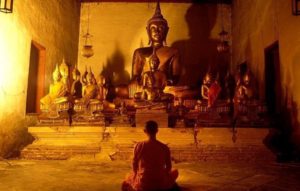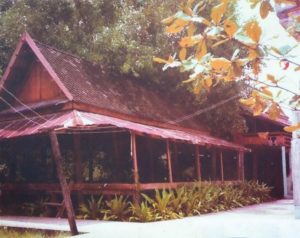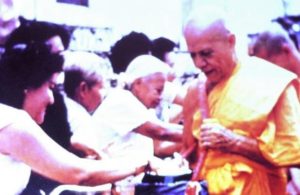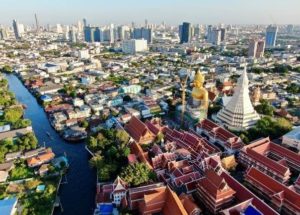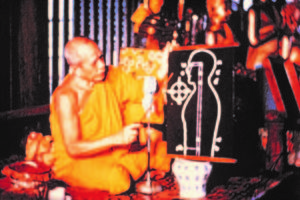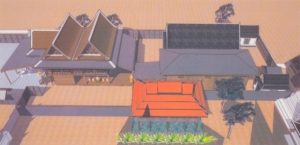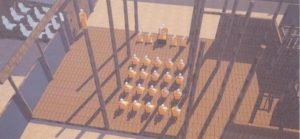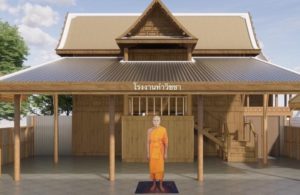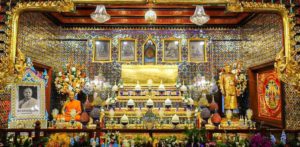ชีวประวัติพระเดชพระคุณหลวงปู่
พระมงคลเทพมุนี (สด จนฺทสโร) พระผู้ปราบมาร
Biography of Luangpu
The Great Master Phramongkolthepmuni (Sodh Candasaro)
The Vanquisher of Mara
降魔尊者—帕蒙昆贴牟尼祖师(术.湛塔萨罗)传记
ชาติกำเนิดและชีวิตวัยเยาว์
Birth and Early Life
出生和家世
พระมงคลเทพมุนีท่านมีนามเดิมว่า สด มีแก้วน้อย
เป็นบุตรของ นายเงิน มีแก้วน้อย และนางสุดใจ มีแก้วน้อย เกิดเมื่อวันศุกร์ ที่ 10 ตุลาคม พ.ศ. 2427 ในครอบครัวค้าขายข้าวสาร ณ หมู่บ้านเหนือ อยู่ฝั่งตรงข้ามวัดสองพี่น้อง อ.สองพี่น้อง จ.สุพรรณบุรี
The Great Master Phramongkolthepmuni was born as Sodh Mikaewnoi on Friday, 10 October 1884 (BE 2427) to the family of Nguen and Sutjai Mikaewnoi, a rice merchant in a village opposite Wat Songpinong, Songpinong District, Suphanburi Province, Thailand.
佛历2427年(1884年)10月10日,祖师出生于素攀府颂丕农县颂丕农村一户以买卖稻米为生的家庭。祖师俗名术.弥给诺,父亲名艮. 弥给诺,母亲名素在. 弥给诺。
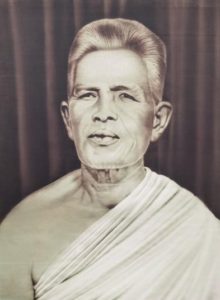
นางสุดใจ มีแก้วน้อย
Sutjai Mikaewnoi
素在. 弥给诺
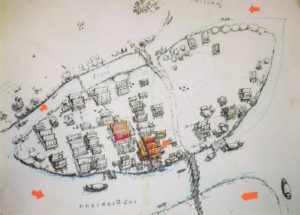
แผ่นดินใบบัว | ในอดีต
Lotus Land (past)
莲叶之乡(从前)
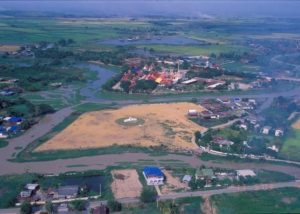
แผ่นดินใบบัว | ในอดีต
Lotus Land (today)
莲叶之乡(从前)
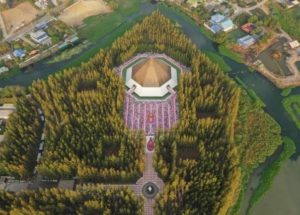
แผ่นดินใบบัว | ปัจจุบัน
Lotus Land (today)
莲叶之乡(现在)
แผ่นดินใบบัว
Lotus Land
莲叶之乡
แผ่นดินบ้านเกิดของท่าน เป็นรูปร่างคล้ายแผ่นดินรูปใบบัวสองใบ ปัจจุบันนี้เป็นที่รู้จักว่าชื่อ แผ่นดินใบบัว มีเนื้อที่ประมาณ 20 ไร่ เป็นที่ที่ล้อมรอบด้วยน้ำ วัดสองพี่น้องอยู่อีกฝั่งคลองด้านตรงข้าม วัดแห่งนี้เป็นสถานที่ที่ท่านเริ่มเรียนหนังสือเมื่ออายุ 9 ปี
The family house was in the north of the Songpinong commune, on a peculiar piece of land resembling the shape of two lotus buds joined together, and surrounded by water on all sides. The area is known as ‘Lotus Land’ and is approximately eight acres in size. It was positioned to the south of Wat Songpinong, a village temple on the opposite side of the canal, where Sodh began his elementary education at the age of nine.
祖师的家乡地形特殊,犹如两张莲叶,有“莲叶之乡”的美称。面积约为20泰亩,四周河道环绕,河对岸就是颂丕农寺。他九岁时便在该寺开始接受正式的教育。
แผ่นดินบัวแห่งนี้เป็นที่ตั้งของอนุสรณ์สถาน “มหาวิหารพระมงคลเทพมุนี” มีรูปทรงภูเขาทอง 8 เหลี่ยม ภายในได้บันทึกประวัติการสร้างบารมีของท่านตั้งแต่ปฐมวัยจนกระทั่งถึงปัจฉิมวัย บริเวณกลางมหาวิหารประดิษฐานรูปหล่อทองคำของมหาปูชนียาจารย์ พระมงคลเทพมุนี เพื่อให้สาธุชนได้กราบไหว้เพื่อให้ระลึกถึงแบบอย่างคุณธรรมและผลงานของท่านมาเป็นแรงบันดาลใจ
The Memorial Hall of Phramongkolthepmuni is located on Lotus Land. It has the feature of an octagonal mountain of gold and contains the chronicles of Luangpu’s pursuit of Perfections from youth until the final periods of his life. A solid gold statue of the Great Master Phramongkolthepmuni is enshrined inside at the center of the Memorial Hall where laypeople can come to pay respect and be inspired by his remarkable virtues and great contributions to humankind.
如今,在荷叶之乡上巍然耸立着一座形似八角金山的祖师纪念堂。堂内安奉一尊纯金祖师金像,记录了祖师毕生勤修波罗蜜的传奇经历。同时,以此让世人有机会与祖师结缘,缅怀祖师的洪恩和丰功伟绩。
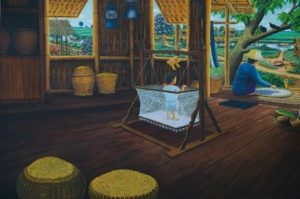
วัยเด็ก มีปัญญาสอนตนเองได้
As a child, he had the ability to teach himself.
自幼就会自我教导
ในวัยเด็ก
Early Life
童年
ในวัยเด็กท่านเป็นเด็กฉลาด ใจคอเด็ดเดี่ยวมั่นคง เมื่อตั้งใจทำสิ่งใดเป็นต้องพยายามทำจนสำเร็จ เมื่อไม่สำเร็จเป็นไม่ยอมเด็ดขาด เช่น ท่านเคยช่วยทางบ้านเลี้ยงวัว เมื่อวัวพลัดเข้าไปในฝูงวัวบ้านอื่น ท่านจะต้องไปตามวัวกลับมาให้ได้ ไม่ว่าวัวจะไปอยู่ที่ไหนดึกดื่นอย่างไรก็ตาม เมื่อไม่ได้วัวมาก็ไม่ยอมกลับ
นอกจากนั้นท่านยังประกอบไปด้วยเมตตาจิตในสัตว์ มีงานอื่นๆ ที่ท่านช่วยพ่อแม่ทำงานอย่างการไถนาทุกเช้า ถ้าใช้วัวไถนาก็จะคอยสังเกตดูดวงตะวันว่าใกล้เพลหรือยัง ท่านจะเลิกตรงเวลาจนโยมพี่สาวนึกว่าท่านขี้เกียจ เพราะเอาแต่ดูเวลาจะพัก อันที่จริงท่านอยากจะให้วัวพัก ถ้าเห็นว่าวัวทำงานเกินกำลังและเหนื่อยมากแล้วก็จะนำไปอาบน้ำจนเย็นสบายและปล่อยให้ไปกินหญ้าอย่างเป็นอิสระ
ในกรณีของท่าน
ท่านถือเมตตาตามคนเก่าแก่ในเรื่องการใช้สัตว์ไถนา เมื่อใดที่กลองเพลบอกเวลาฉันภัตตาหารดังขึ้นก็ควรหยุดงาน ไม่สมควรโหดร้ายกับสัตว์ ท่านทำตามคติโบราณที่ว่า “เพลคาบ่าวัว” ให้เลิกงาน
Sodh Mikaewnoi was an intelligent child with strong willpower. In whatever he had set out to do, he would always persevere until it was done and done well. When he was young, he used to help his mother tend the oxen, and regardless of his young age he would plunge fearlessly into a neighbor’s herd in order to retrieve missing oxen no matter where they might have strayed or how late into the night it might have been. He would never return empty-handed.
Sodh showed signs of compassion even when he was young. While helping his parents plough the rice fields each morning, as it neared midday, he would gaze up to check the position of the sun to note what time it was. His sister thought he was lazy, waiting for the time to take a break, but in fact he was watching for the appropriate time to relieve his ox. If he saw that the oxen had been overworked and had become tired, he would lead them off for a bath before letting them loose to graze.
Sodh shared the same mentality of that of the elders of his generation who believed it was cruel to allow one’s beast to continue plowing past the eleven o’clock drum. He heeded to the age-old proverb: “Eleven kills the buffaloes”.
祖师从小天资聪明,意志坚定,下决心要做的事,一定坚持到底,若未取得成功,必锲而不舍。譬如,他小时候经常帮父母放牛,若牛误入别家牛群,就算日落天黑,也会坚持去寻找,找不着不回家。
此外,祖师自幼心怀慈悲,每天早起帮父母下地耕田,在接近中午时,他总会抬头观望天上的太阳,看是否到了该让牛休息的时间。他会准时让牛休息,为此还被大姐指责说借机偷懒。但事实并非如此,而是怜惜牛只,不让它在烈日下过度劳作。每当看见牛只疲惫不堪时,他就会领着牛只到河边洗澡,然后放它吃草。
他长期遵循老一辈人的做法,悉心照顾耕作的牲畜,准时让它们休息,不会过分苛待,诚如谚语所说:十一点钟的太阳能杀死水牛。
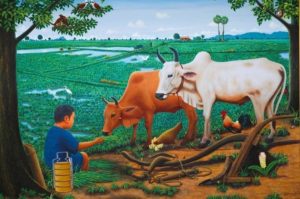
“เพลคาบ่าวัว เราจะไม่ประพฤติเด็ดขาด”
十一点钟的太阳能杀死水牛,我绝不会苛待它。
“Eleven kills the buffaloes [proverb]; I’d never do that.”
การศึกษาเมื่อเยาว์วัย
Education During His Youth
童年的教育
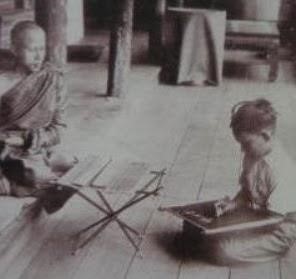
ท่านเรียนหนังสือกับพระภิกษุน้าชาย (ปู่นะ) ณ วัดสองพี่น้อง จ.สุพรรณบุรี
Sodh studied with his uncle Nah, a monk at Wat Songpinong, Suphanburi.
随出家叔父在素攀府颂丕农寺读书识字
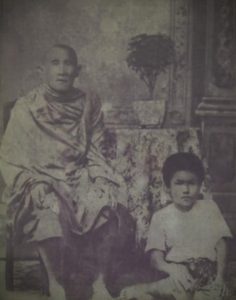
ศึกษาอักษรสมัยกับพระอาจารย์ทรัพย์ ณ บางปลา อ.บางเลน จ.นครปฐม
Sodh studied Thai and Khom with Ven. Ajarn Sab at Wat Bang-pla, Bang-lane District of Nakorn Pathom Province.
随萨法师在佛统府挽铃县邦巴寺读书识字
เมื่อท่านอายุ 9 ปี ได้มีโอกาสเรียนหนังสือตามแบบแผนกับพระภิกษุผู้เป็นน้าชายของท่านที่วัดสองพี่น้อง จ.สุพรรณบุรี
When Sodh was nine he had the chance to begin his formal education with his uncle, a monk at Wat Songpinong, Suphanburi Province.
祖师九岁时才有机会接受正式教育,随出家的叔父在素攀府颂丕农寺读书识字。
ท่านไปเรียนต่อที่วัดบางปลา จ.นครปฐม ซึ่งเป็นจังหวัดบ้านเกิดครอบครัวฝ่ายพ่อของท่าน ที่นั่นท่านได้เรียนการอ่านและการเขียนภาษาไทยและภาษาขอมอย่างถูกต้องจากพระอาจารย์ทรัพย์
After his uncle moved to a temple in Thonburi, Sodh continued his study at Wat Bang-pla, a temple in Nakorn Pathom Province, the home town of his father’s side of the family. There, he studied Thai and Khom under the tutelage of Ven. Ajarn Sab until he was able to read and write both languages fluently.
后来,祖师来到父亲的故乡——佛统府的邦巴寺,随萨法师学习泰文和高棉文,能够流利地阅读和书写。
เหตุที่ปฏิญาณตนบวชจนตาย
Resolution to Devote His Life to the Monkhood
立誓终生出家
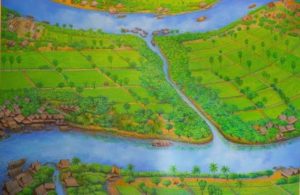
คลองบางนางแท่น (คลองบางอีแท่น) อ.สามพราน จ.นครปฐม
Bang Nang Taan Canal (formerly Bang Etan Canal)
Sampran District, Nakorn Pathom Province
佛统府三潘县帮依叹河
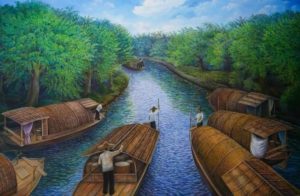
ท่านตั้งสัจจะอธิษฐานที่ท้ายเรือ ตอนอายุครบ 19 ปี
At the age of 19, he made the earnest resolution while sitting at the stern.
祖师十九岁时在船尾生起出离心
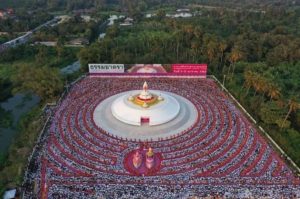
อนุสรณ์สถานบางนางแท่น (ปัจจุบัน) อ.สามพราน จ.นครปฐม
อนุสรณ์สถานลำดับที่ ๒ สถานที่ตั้งมโนปณิธานบวชตลอดชีวิต
Memorial Hall of Phramongkolthepmuni, Bang Nang Taan Canal (today)
Sampran District, Nakorn Pathom Province.
Site of the second Memorial Hall of Phramongkolthepmuni
The location where the resolution to ordain as a monk for life was made.
第二处圣地:立誓终生出家之地——三潘县帮依叹河(现在)
เหตุที่ปฏิญาณตนบวชจนตาย
Devoting His Life to the Monkhood
立誓终生出家之缘起
เมื่ออายุ ๑๔ ปี บิดาได้เสียชีวิตลง เนื่องจากตรากตรำในการค้าข้าว ท่านจึงต้องมารับช่วงคุมงานแทน
เมื่ออายุ ๑๙ ปี วันหนึ่งระหว่างทางกลับจากการค้าข้าว ท่านล่องเรือพร้อมคนงานนำเรือเปล่ากลับบ้าน พร้อมกับเงินจำนวนมากที่ได้รับมาจากการขายข้าว จำเป็นต้องผ่านมาทางคลองเล็กซึ่งเป็นคลองลัดชาวบ้านเรียกว่า “คลองบางอีแท่น” คลองนี้เป็นคลองแคบๆ มีโจรผู้ร้ายชุกชุม
ท่านซึ่งยืนถือท้ายเรืออยู่และเป็นจุดสำคัญที่โจรจะทำร้ายได้ก่อน ด้วยสัญชาตญาณเอาตัวรอดเลยเรียกคนงานสับเปลี่ยนให้มาถือแทน ส่วนท่านหยิบปืนยาวไปถ่อเรือแทนลูกจ้างทางหัวเรือ พอเรือแล่นเข้าที่เปลี่ยวเข้าไปเรื่อยๆ พลันก็เกิดความคิดแวบขึ้นมาว่า
“คนพวกนี้ เราจ้างเขามาเพียง ๑๑ – ๑๒ บาท เท่านั้น ส่วนตัวเราเป็นทั้งเจ้าของทรัพย์และเจ้าของเรือ เมื่อมีภัยใกล้ตายกลับโยนไปให้ลูกจ้าง”
Sodh was fourteen when his father passed away. As the eldest son, the burden of running the family business and supporting his mother and family fell on his young shoulders.
A turning point in his life came when he was 19. In one trading trip to Bangkok in 1903, as Sodh headed home with his crewmen on the empty barge and a large sum of money from selling all the rice, he took a detour through a remote waterway known as Bang Taan Canal. This was a narrow stretch of canal dreaded by boatmen because it was infested with pirates and bandits.
Sodh’s survival instinct told him that he should switch his position from the helm to the front of the barge to avoid danger, so he ordered his crewman at the front to take his place at the helm. Sodh grabbed the rifle and strode towards the bow as the boat gradually glided into a remote part of the canal. Then a guilty conscience struck him. He thought:
“All the crew gets from me for looking after this wretched barge is eleven or twelve baht a month (equivalence of 50-60 cents in those days). As for me, I am the owner of the boat and have all the money. If I hand down death to my less-than-fortunate workers, I would be taking advantage of a fellow man.”
祖师十四岁那年,突然传来父亲逝世的消息,身为长子的他不得不担负起维持全家生计的生意。后来,在十九岁那年,有一次卖完稻米后,他携带所得款项与雇工们划着两艘空货船返程。途中需经过一段狭长河道,当地人称为“帮依叹河”,该河道狭长,且布满急湍与伏流,常有盗贼出没。
当时他心里想:自己站在船尾掌舵,若真遇到盗贼抢劫,必定成为首个被害的人,不如与船头的雇工对换位置。随后他又转念一想:
“这些为我工作的雇工,每月只赚十一至十二铢的工钱,剩下的钱全归自己所有,如今遇到危险,自己怎能让他们身处险境呢?”
เมื่อคิดตำหนิตัวเองเช่นนี้ก็ไม่อยากเอาเปรียบลูกจ้าง ท่านจึงตัดสินใจกลับมาถือท้ายเรือตามเดิมยอมเสี่ยงรับอันตรายแต่ผู้เดียว เมื่อเรือพ้นคลองมาได้ ท่านก็มาพิจารณาเห็นว่า
“การหาเงินเลี้ยงชีพนั้นลำบากมากจริงๆ ต้องทรหดอดทนกว่าจะเก็บเงินสร้างฐานะให้มั่นคง ถ้าใครไม่รีบหาให้มั่งมีก็ไม่มีใครนับหน้าถือตาในสังคม ไม่ทัดเทียมหน้าคนอื่น บรรพบุรุษของเราก็ขวนขวายทำมามหาเลี้ยงชีพสร้างฐานะเหมือนกัน ตอนมีชีวิตอยู่ก็แสวงหาความมั่งคั่งร่ำรวย แต่เมื่อตายไปแล้วไม่เห็นมีใครเอาทรัพย์ติดตัวไปสักคน ทุกคนล้วนตายหมด พ่อของเราก็ตาย เราก็จะต้องตายเช่นกัน ตายแล้วเอาอะไรไปไม่ได้”
He felt ashamed for having made such a selfish move. He called the crewman back to the oars and sat at the tiller with the rifle in his lap. Although he managed to pass through the crisis in safety, the whole episode left him with a deep sorrow for his fellow men.
“Making a living is such a hard thing indeed, to go through such an ordeal to avail oneself of a day’s wage. Material wealth is so ingrained in a man’s values that he loses touch with the reality and true purpose of life. Does society so despise the un-made man to ostracize him until he can earn himself riches? Our ancestors did the same things. While alive on earth, they sought only wealth; but when one pass away, they could not take anything with them. In the end everyone must die. My father has died, and I will die as well. And we cannot take anything with us.”
如此想后,他决定放弃与雇工对换位置,仍然站在船尾掌舵,独自承担危险。当船使出河道,脱离险境的那一刻,他顿然领悟到:
“谋生养家真难,必须辛苦地赚钱,富裕起来才能获得社会地位,若不如他人富有,没有对称的地位,很难获得他人的尊重,自己也会觉得没面子。祖辈们也是如此奋斗过活,为追求财富和地位忙碌一生,可死后什么也带不走。人固有一死,父亲已故,自己也会死去,可死后什么都带不走。”
ท่านจึงได้ตั้งสัจจะอธิษฐานว่า “ขอเราอย่าได้ตายเสียก่อนเลย ขอให้ได้บวชเสียก่อน เมื่อบวชแล้วจะไม่ลาสิกขา ขอบวชไปจนตลอดชีวิต”
He had made his resolution as:
“Don’t let me die before I have a chance to ordain! If I can ordain, I would devote my life to monkhood until my days.”
随后,祖师虔诚立誓道:“切莫让我出家前死去,愿此生得以出家,出家后愿终生为僧,绝不舍戒还俗。”
หลังจากที่ได้ตั้งสัจจะอธิษฐานอย่างแน่วแน่แล้ว แต่ท่านไม่ได้ปล่อยปละละเลยหน้าที่ที่ต้องดูแลแม่และครอบครัว ท่านวางแผนที่จะทำงานสะสมทรัพย์สินให้แก่แม่และพี่น้องเพื่อว่าเมื่อท่านไม่อยู่แล้วพวกเขาจะได้ไม่ลำบาก นับว่าท่านเป็นคนมีความกตัญญูกตเวทีต่อมารดาของท่านเป็นอย่างยิ่ง
After that incident the thought of ordaining as a Buddhist monk never left Sodh’s mind. He knew he could not shrug off the responsibilities to take care of his mother and the family. He planned to leave them enough savings to support themselves in his absence. The kindness of his heart demonstrated to the great gratitude he has for his mother.
虽然祖师已经立誓终生出家,但没有立刻舍弃奉养母亲的职责,而是更加辛勤工作,积蓄足够母亲和姐弟们生活所需的钱财。就算未来出家,家人也可以衣食无忧。由此可见,祖师对母亲十分孝顺。
- อุปสมบท
4.出家
4.Ordination
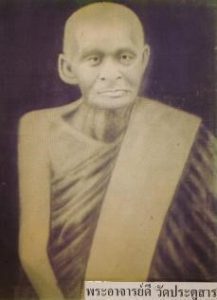
พระอาจารย์ดี วัดประตูศาล อำเภอเมือง จังหวัดสุพรรณบุรี เป็นพระอุปัชฌาย์
Ven. Ajarn Dee Wat Pratusarn, Muang District, Suphanburi Province
Ordination preceptor
戒师:迪法师
素攀府八度山寺
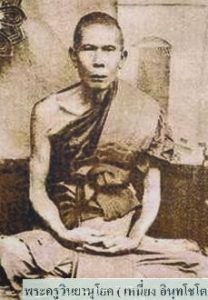
พระครูวินยานุโยค (เหนี่ยง อินฺทโชโต) วัดสองพี่น้อง อ.สองพี่น้อง จ.สุพรรณบุรี
พระกรรมวาจาจารย์
Ven. Phrakru Vinyanuyok (Nieng Indachotho)
Wat Songpinong, Songpinong District, Suphanburi Province
The senior ordination-teacher
羯磨师:温雅努优法师
素攀府颂丕农县颂丕农寺
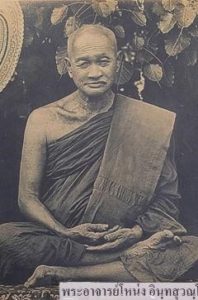
พระอาจารย์โหน่ง อินทสุวณโณ วัดสองพี่น้อง อ.สองพี่น้อง จ.สุพรรณบุรี เป็นพระอนุสาวนาจารย์
Ven. Noeng Indasuvanno
Wat Songpinong, Songpinong District, Suphanburi Province
The junior ordination-teacher
教授师:浓因塔素宛诺法师
素攀府颂丕农县颂丕农寺
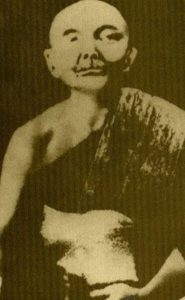
หลวงพ่อเนียม วัดน้อย อ.บางปลาม้า จ.สุพรรณบุรี
Ven. Luangpor Niam
Wat Noi, Bang Plama District, Suphanburi
念法师
素攀府邦巴玛县诺寺
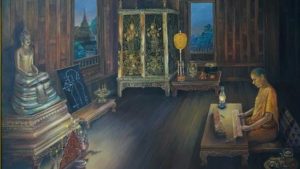
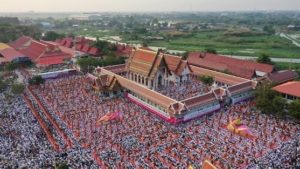
วัดสองพี่น้อง ณ วัดสองพี่น้อง อ.สองพี่น้อง จ.สุพรรณบุรี
อนุสรณ์สถานลำดับที่ ๓ สถานที่เกิดใหม่ในเพศสมณะ
Wat Songpinong Songpinong District, Suphanburi Province
Site of the third Memorial Hall of Phramongkolthepmuni
Place of Ordination
第三处圣地:出家之地——素攀府颂丕农县颂丕农寺
เมื่ออุปสมบทแล้ว
After Ordination
出家后
ท่านอุปสมบทเป็นพระภิกษุเมื่อเดือนกรกฎาคม พ.ศ.2449 ณ วัดสองพี่น้อง ได้รับฉายาว่า จันทสโร หมายถึง ผู้นำแสงสว่างมาสู่โลก ประดุจพระจันทร์ส่องสว่างยามราตรี
Ordained as a monk in July 1906 (BE 2449) at Wat Songpinong, Sodh was given the monastic name ‘Candasaro Bhikkhu,’ a Pali name which means “the one with a bright radiance like the moon”.
佛历2449年(1906年)7月,祖师如愿在素攀府颂丕农县颂丕农寺出家受戒,法名“湛塔萨罗”,意指为世界带来光明的人,犹如月亮照亮黑夜。
เมื่อบวชแล้วพอรุ่งขึ้นอีกวัน หลวงพ่อก็เริ่มลงมือปฏิบัติพระกรรมฐานต่อกับพระอาจารย์เนียม วัดน้อย อำเภอบางปลาม้า จังหวัดสุพรรณบุรี ได้ไปจำพรรษาอยู่วัดสองพี่น้อง 1 พรรษา
The day after entering the monkhood, Candasaro began to practice meditation with Ven. Ajarn Noeng Indasuvanno, the junior ordination-teacher. After a year, he continued practicing meditation with Ven. Ajarn Niam of Wat Noi, Bang Plama District, Suphanburi.
祖师出家后第二天,就开始跟随素攀府邦巴玛县诺寺的念法师学习禅法。后来,又到颂丕农寺结雨安居。
การศึกษาปริยัติธรรม
精进修行
Pali Studies
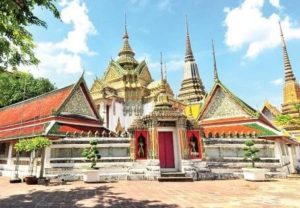
วัดพระเชตุพนวิมลมังคลารามราชวรมหาวิหาร(วัดโพธิ์)
Wat Phra Chetuphon (Wat Bhodi)
卧佛寺
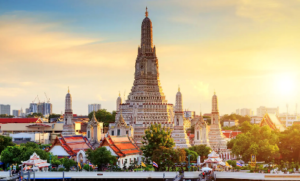
วัดอรุณราชวราราม
Wat Arun Ratchawararam (Bangkok)
黎明寺
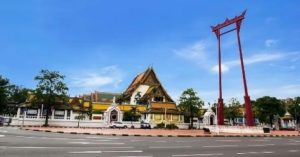
วัดสุทัศนเทพวราราม
苏泰寺
Wat Suthat Thepwararam
การศึกษาพระปริยัติธรรม
深入经藏
Scripture Studies
หลังจากออกพรรษาที่วัดสองพี่น้องแล้ว หลวงพ่อก็ได้ย้ายไปจำพรรษาอยู่ที่วัดพระเชตุพนวิมลมังคลาราม เพื่อแสวงหาความรู้ให้แตกฉานกว้างขวางและลึกซึ้งยิ่งขึ้นในด้านปริยัติธรรม สิบปีผ่านไป ท่านมีความรู้ภาษาบาลีแตกฉานสามารถที่จะอ่านมหาสติปัฏฐานสูตรในคัมภีร์บาลีแล้ว ท่านจึงวางธุระการศึกษาฝ่ายภาษาบาลีลง และใช้เวลากับวิปัสสนาธุระอย่างเต็มที่
After his first year of ordination, Candasaro Bhikkkhu left Wat Songpinong to further his scripture studies at Wat Phra Chetuphon. He put much time in his studying Pali and practicing meditation. Ten years later, he could translate Pali like an expert and read the Mahasatipatthana Sutta from the Pali scriptures. He then discontinued studying the scriptures and devoted himself to the practice of meditation.
在颂丕农寺雨季安居结束后,祖师前往曼谷的卧佛寺常住,进一步研习经藏和修习禅定。十年之后,他的巴利文造诣已经相当精深,能够准确流畅地翻译出《大念处经》。最后,他决定暂停钻研经典,专心精进修习毗婆舍那。
การเข้าถึงวิชชาธรรมกาย
Attainment of the Dhammakaya Knowledge
证入法身
ย่างเข้าพรรษาที่ 12 ของท่าน ประมาณปี พ.ศ.2460 เมื่อหลวงพ่อได้ฝึกปฏิบัติสมถวิปัสสนาแล้ว ท่านได้เดินทางจากวัพพระเชตุพนวิมลมังคลารามไปจำพรรษาที่ ณ วัดโบสถ์ (บน) ตำบลบางคูเวียง นนทบุรี อันเป็นสถานที่สงบวิเวก
During his twelfth year of meditation practice (around 1917), Candasaro Bhikkhu moved from Wat Phra Chetuphon to spend his Rains-retreat at Wat Bote-bon, Bangkuvieng District, Nonthaburi Province.
佛历2460年(1917年),正值祖师出家第十二年,他决定离开卧佛寺,前往暖武里府挽粿县邦库威镇僻静的博奔寺结雨安居。
ก่อนหน้านี้ท่านได้มีความคุ้นเคยกับหลวงพ่อนก เจ้าอาวาสวัดโบสถ์บน เนื่องจากท่านเคยมาจำพรรษาที่นี้ซึ่งเป็นสถานที่เงียบสงบแวดล้อมไปด้วยป่ามีความเป็นสัปปายะเหมาะสมกับเป็นสถานที่ที่ฝึกปฏิบัติธรรม และอีกเหตุผลหนึ่งนั้นคือท่านตระหนักเสมอมาว่าท่านยังไม่เข้าถึงธรรมตามที่พระบรมศาสดาได้ตรัสรู้
While at Wat Phra Chetuphon, he became acquainted with Ven. Nok, the abbot of Wat Bote-bon, a temple situated in a forest environment and with many trees on the temple grounds. It was peaceful and conducive to meditation. After eleven years of practice, Candasaro still felt he had yet to attain the ultimate knowledge realized by the Buddha.
祖师此前就与博奔寺住持诺法师结识,也曾经在此结雨安居。这里树木茂密,悠然僻静,非常适合禅修。此外,祖师觉得自己出家多年,却一直未证悟佛陀所证之法。
The main chapel of Wat Bote-bon
A pavilion hall at Wat Bote-bon
ท่านตั้งใจเลือกตอนเย็นวันพระ ขึ้น 15 ค่ำ เดือน 10 ปี พ.ศ.2460 หลังจากได้ลงโบสถ์ร่วมสวดพระปาติโมกข์กับหมู่สงฆ์แล้ว พระภกิกษุสดท่านได้เข้าไปนั่งสมาธิที่ในโบสถ์ ต่อหน้าพระประธาน แล้วได้ตั้งสัตยาธิษฐานว่า
He finalized his choice on the full moon day of the tenth lunar month of the year 1917, in the afternoon, after finishing the Patimokkha chanting along with other monks, Phra Candasaro proceeded to the main chapel to meditate. Sitting in front of the Buddha statue, he made this solution:
佛历2460年(1917年)10月的月圆日,傍晚时分,祖师随僧团诵完波罗提木叉后再次进入大雄宝殿,面对佛像虔诚发愿道:
“เมื่อนั่งลงแล้ว หากมิได้บรรลุธรรม ดังที่พระพุทธองค์ทรงเห็นทรงตรัสรู้แล้ว ก็จะไม่ขอลุกขึ้นจากที่อีกจนตลอดชีวิต”
“Upon this sitting, if I cannot attain even a small part of the ultimate Dhamma realized by the Buddha, then I shall sit unmoved in this spot…or die in the attempt.”
เมื่อใจท่านตั้งมั่นแล้ว ก็เริ่มปรารภนั่ง และกราบทูลขอพระมหากรุณาธิคุณอาราธนาองค์สมเด็จพระสัมมาสัมพุทธเจ้า ด้วยสัตยาธิษฐานอย่างตั้งมั่นอุทิศชีวิตเพื่อให้ได้บรรลุมรรคผล
He pleaded to the Buddha with a strong resolution to dedicate his life for the goal of insight:
祖师下定决心后,盘坐在佛像前,望着佛陀慈悲的尊容,再次发愿道:
“ขอพระองค์ได้ทรงพระกรุณาโปรดข้าพระพุทธเจ้า ทรงประทานธรรมที่พระองค์ได้ตรัสรู้ ถ้าข้าพระพุทธเจ้ารู้ธรรมของพระองค์แล้วเป็นคุณและเกิดประโยชน์แก่พระพุทธศาสนา ขอพระองค์ทรงพระกรุณาโปรดพระราชทานธรรมะอันยิ่งใหญ่นั้นด้วยเถิด ข้าพระองค์ขอรับเป็นทนายแก้ต่างในศาสนาของพระองค์ไปจนตลอดชีวิต แต่หากข้าพระพุทธเจ้ารู้ธรรมของพระองค์แล้วเป็นโทษแก่ศาสนาและไม่เกิดประโยชน์ ข้าพระพุทธเจ้าจักขอสละชีวิตปฏิบัติธรรมเป็นพุทธบูชาเพียงเท่านั้น”
“May the Most Exalted One show me compassion and grant me the least and easiest of Thy Enlightened Knowledge. Should my attainment of Thy Enlightened Knowledge bring harm to Buddhism, don’t grant it to me; but if it can benefit Buddhism, then, O Lord, please grant it to me. I shall be Thy champion to uphold the greatest of Thy Teachings until the last day of my life. But should my Enlightenment be in a vain, of no benefit to Thy Teachings, then I will sacrifice my life in this meditation as the only offering I have for Thee.”
“祈求世尊慈悲,赐予弟子世尊所证之法。如果弟子所证悟的佛法能广泛利益佛教,就祈求世尊慈悲加持,使弟子顺利证悟,弟子自愿作为佛教正名的辩护者。倘若弟子的证悟有害于佛教,则无需劳驾世尊加持,弟子将奉献生命,以报佛恩。”
ในคืนนั้นพระภิกษุจันทสโรท่านได้นั่งขัดสมาธิคู้บัลลังก์ เข้าสู่สภาวธรรมที่ลุ่มลึกไปเรื่อยๆ วันนั้นฝนตกหนักมาก สภาพแวดล้อมรอบๆ โบสถ์ชื้นแฉะ ท่านเห็นมดเดินเป็นแถวหนีฝนมาตามแนวร่องไม้ จึงได้เอานิ้วจิ้มลงไปในขวดน้ำมันก๊าดแล้วเริ่มจะขีดวงรอบตัวเพื่อไม่ให้มดมารบกวนการนั่งสมาธิ แต่ฉุกใจคิดขึ้นได้ว่าท่านได้บวชอุทิศชีวิตต่อคำสอนของพระบรมศาสดาแล้ว ทำไมจะต้องมาลังเลใจกับเรื่องมดตัวเล็กๆ พวกนี้ ท่านจึงได้วางขวดน้ำมันก๊าดให้ออกห่างจากตัวด้วยความรู้สึกว่าทำไมตัวเราถึงได้น่าชังอะไรเช่นนี้
That evening, Candasaro sat in a half-lotus position and began his deep meditation. It started to rain heavily. The atmosphere in the temple became damp. He saw a line of ants escaping from a crack in the floor. For a moment he thought that the ants might come and disturb his meditation, so he dipped his finger into a kerosene bottle nearby and began to draw a circle around himself to prevent the ants from entering. But then he realized that he had just made a vow, willing to give up his life in the pursuit of the Dhamma. Why should he be afraid of these little ants? In self-disgust, he put the kerosene bottle away and set forth to meditate unprotected.
ใจของท่านตั้งมั่นขึ้นเรื่อยๆ ในขณะที่เวลาก็ล่วงเลยดึกสงัด ในสมาธิมีความสว่างจากดวงธรรมเกิดขึ้นซึ่งเป็นดวงธรรมที่ท่านเคยเห็นภายในสมาธิที่เมื่อกลางวันตอนเพลท่านเห็นว่าเป็นดวงสว่างขนาดเดียวกัน คือขนาดเท่าประมาณฟองไข่แดงของไข่ไก่อยู่ภายในศูนย์กลางกายของท่าน ในขณะที่ท่านนั่งสมาธิไปเรื่อยๆ ดวงกลมๆ นั้นก็เพิ่มความสว่างขึ้น เป็นดวงที่ใสแจ่มไม่มีร่องรอยตำหนิราวกับแก้วที่เจียรนัยมาอย่างดีแล้ว สว่างไสวเพิ่มมากขึ้นจนกระทั่งสว่างราวกับดวงอาทิตย์เที่ยงวัน ท่านจดจ่อเฝ้าดูดวงใสนี้เป็นชั่วโมงจนกระทั่งถึงเที่ยงคืนโดยไม่ได้ทำอะไรเนื่องจากไม่มีใครชี้แนะอะไรว่าให้ทำอย่างไรต่อไป ยังคงจ้องมองดวงภายในที่ตรงกลางดวงสว่างนั้นอย่างตั้งใจ ท่ามกลางวามเงียบสงบได้มีเสียงดังออกมาจากภายในกลางดวงนั้นว่า “มัชฉิมา ปฏิปทา” ตรงกับความหมายในภาษาบาลีว่า “เส้นทางสายกลาง”
His mind began to settle as he meditated far into the night. The bright, clear sphere of Dhamma that he saw earlier that morning reappeared and became even clearer and more radiant. As he meditated, the clarity of the sphere increased until it was as lucid as a flawless sphere of crystal. The brightness grew more intense until it outshined the midday sun. He contemplated on this sphere for hours, from early in the evening until well after midnight, not knowing how to progress to the next level. In all his training, there had been no master who had reached this level of experience. Candasaro focused his attention at the center of the bright sphere. Then, coming from the silence at the center of the sphere, there arose the gentle sound of the ancient words, ‘majjhima-patipada’, a term from the ancient Pali meaning ‘Middle Way’.
“นี่แหละเส้นทางสายกลางที่เคยเรียนในจารึกคัมภีร์ เราต้องทำใจให้อยู่ในทางสายกลางซึ่งอยู่ระหว่างเส้นทางสุดโต่งสองสายคือ อัตตกิลมถานุโยคกับกาเมสุขาลิกานุโยค
“这就是中道吧!在经典里的意思是:调心不要太紧,也不要太松。”
แต่แล้วได้มีเสียงยืนยันที่ดังมาจากกลางกายของท่าน ในกลางดวงธรรมสว่างทรงกลมได้มีความสว่างที่ไม่ธรรมดาราวกับส่องมาจากแหล่งที่มาภายในกลางตัวของท่าน มีความสว่างไสว มีความนิ่งแน่น เย็นสบายและมีความนุ่มนวล ความสว่างกระจ่างใสได้ส่องประกายออกมาเนื่องจากเพิ่มขีดความสว่างมากขึ้นๆ จากภายในกลางดวงทรงกลมที่ท่านรู้ว่ามีบางสิ่งบางอย่างอยู่ภายในกลางนั้นและเริ่มตระหนักว่าทางสายกลางเป็นเส้นทางนำเข้าไปสู่กายภายในทั้งหลาย
But now this sound came from the center of his body. The center of the sphere was becoming inordinately bright as if it were the source of all the brightness in his body: bright, intense, cool, and soothing. The illumination blazed so that the brightness increased enormously and deep in the brightness of the sphere he knew there existed something else. Then, he started to realize that there must be a hidden meaning to the term ‘Middle Way’. That tiny spot in the center of his body might be the doorway to hidden inner dimensions.
那个声音从他身体中央传出后,光球的中心显现出一个光点,异常的光亮,就像是内在明亮的光源,光亮、稳定、清凉、柔和。这个光点的亮度不断增加,祖师知道还有其他东西存在,并意识到中道就是深入内在的通道。
ท่านจึงทดสอบด้วยการทำใจนิ่งๆ มองเฉยๆ เฝ้าดูในสมาธิในกลางกายนั้นไปเรื่อยๆ จนกระทั่งดวงสว่างขยายออกไปๆ จากเดิมขนาดเท่าฟองไข่แดงของไข่ไก่ ดวงธรรมได้ขยายใหญ่โตขึ้นเรื่อยๆ จนสุดขอบฟ้า สว่างไสวมากกว่าขอบฟ้าหลายๆ ชั้นฟ้า จากนั้นก็เปลี่ยนเป็นดวงใหม่ ดวงก็เพิ่มขนาดความสว่างใหม่มองลึกลงไปภายในกลางดวงสว่างก็เกิดดวงสว่างใหม่เป็นชั้นๆ เข้าไป ราวกับดวงสว่างที่ผุดซ้อนขึ้นมามีมากมายเป็นพันๆ ดวง ผลัดเปลี่ยนขึ้นแล้วขยายความสว่างออกไปดวงแล้วดวงเล่า ท่านก็ยังคงนั่งสมาธิในท่าเดิมเช่นนั้น
He then tried an experiment: contemplating deeper and deeper at the center of the bright spot. It started to expand until it reached the size of an egg yolk. Meanwhile, the former sphere also gained in size until it became so huge that it reached the horizons and then faded away. When he contemplated deeper at the center of the new sphere, another one appeared at its center. He continued this experiment, concentrating deeper at the center of each successive sphere. More and more spheres appeared—thousands of them, each one replacing the last as if shooting from a water fountain. As he meditated deeper, each new sphere was brighter and clearer than the last.
随后,他尝试让心继续深入静定,看会有什么变化。果然那个光点慢慢扩大,大到与原先的光球一样大小,原先的光球便消失不见了。接着又有新的光球出现,好像喷泉般一个接一个浮现上来,一个比一个更光亮。虽然光球持续不断地呈现,而且越来越光亮,但祖师依然静静地入定。
จนกระทั่งการนั่งสมาธิเข้าสู่ระดับที่ลึกที่ทำให้มองเห็นกายภายในเป็นกายระดับต่างๆ ที่ซ้อนๆ กันสลับขึ้นมากับดวงธรรมภายในเป็นกายต่างๆ ที่มีความสว่างไสวมากขึ้นตามลำดับ กายละเอียดภายในเหล่านี้มีอยู่ภายในตัวของมนุษย์ทุกคนในโลกนี้ เมื่อใจของท่านนิ่งสนิทและมีความสงบแน่นแล้วจะพบกายเหล่านี้ทุกคน แต่ละกายผุดซ้อนขึ้นมาล้วนสว่างกว่ากายเดิม มีความสวยสง่างามมากกว่ากายที่เห็นก่อนหน้า ซ้อนขึ้นมาทีละกายมีขนาดใหญ่กว่า สว่างไสวและสวยงามมากกว่า
Going yet deeper he could see the transcendental nature of himself—a crystal clear inner body that resides within every human being. As his mind had continued to be perfectly calm and still, several transcendental bodies appeared, one after another, each new one bigger, brighter, and more beautiful than the previous one.
持续深入静定将看见内在的种种身相,一尊接一尊随光球呈现上来。这些细腻的身相就存在每个人的体内,只要心静定到一定程度,就能够看见这些身相。呈现上来的身相越来越硕大和细腻,也越来越纯净、光亮和庄严。
ในที่สุดในสมาธิได้พบกายภายในที่เป็นกายตรัสรู้มีลักษณะคล้ายองค์พระปฏิมานั่งขัดสมาธิ เป็นคล้ายพระพุทธเจ้ากำลังนั่งสมาธิอยู่ ที่บนยอดพระเศียรเป็นลักษณะเกศดอกบัวตูม องค์พระสว่างไสวมาก ชัดเจนใสมาก สวยงามมากไม่มีที่ติ สวยงามกว่าพระพุทธรูปใดๆ ในโลกนี้ นี้คือกายตรัสรู้ธรรม นี้คือการเข้าถึงธรรมภายในที่เรียกว่า “เข้าถึงธรรมกาย” พระภิกษุจันทสโรได้รับประสบการณ์มหัศจรรย์จากภายในสมาธิทำให้ท่านค้นพบว่าภายในกายของมนุษย์ทุกคนมีกายละเอียดอยู่ภายใน ทุกคนสามารถเข้าถึงธรรมกายได้ถ้าทำใจให้ใสละเอียด
Until, finally, a supremely bright and pure image resembling that of the Buddha appeared. It is of the form of the Buddha sitting deep in meditation, the crest of his crown shaped like a lotus bud. It is an image brighter, clearer, more beautiful, and more marvelous than any Buddha image in the world.
This was ‘Dhammakaya’—Body of Enlightenment.
Arriving at this stage of experience in meditation is called “attaining Dhammakaya”. Through this marvelous experience, Candasaro discovered that at the innermost part of every human being, there exists the seed of Enlightenment, the Buddha-nature—the potential to become a Buddha.
最后,祖师看见了莲苞顶髻状的法身佛,呈禅坐入定的姿态。这尊内在的法身佛比世上任何一尊佛像都更加清净、光亮和庄严,这个境界称为“证入法身”。祖师不仅通过打坐入定体证前所未有的殊胜经验,还证实了每个人的体内都有细腻之身,只要心足够细腻和静定,就能够证入法身。
ทันใดนั้น ก็มีเสียงของกายธรรมพระพุทธเจ้าตรัสด้วยพระสุรเสียงก้องกังวานว่า “ถูกต้องแล้ว”
As he contemplated further, with a mind as bright and clear as a mirror, a voice echoed from the center of the Dhammakaya with these words: “That is right!”
随后,祖师仿佛听到法身佛的声音“如是!如是!”响起。
ความปลื้มปีติใจเป็นล้นพ้นได้บังเกิดขึ้นกับท่านจนรำพึงขึ้นว่า
“อ้า นี่มันยากอย่างนี้นี่เอง ถึงได้ไม่บรรลุกัน ความเห็น ความจำ ความคิด ความรู้ ต้องรวมเป็นจุดเดียวกัน เมื่อหยุดแล้วจึงดับ เมื่อดับแล้วจึงเกิด นี่เป็นของจริง หัวต่อมีอยู่ที่ตรงนี้ ทุกสิ่งต้องถูกส่วน”
(คำอธิบาย:ถ้าใจยังคงฟุ้งซ่านก็จะยังไม่หยุดนิ่ง หากทำใจให้นิวรณ์ 5 ที่เป็นอุปสรรคต่อการทำสมาธิจะหมดไป การบรรลุธรรมจึงจะเกิดขึ้น นี้เป็นที่มาของคติพจน์ของท่านที่ว่า “หยุดเป็นตัวสำเร็จ”)
Feeling elated, Candasaro muttered to himself:
“Ah, it is so hard like this… how could anybody perceive it? It is beyond perception, memory, thought, and cognition…all these things must come to a standstill and be united as one single point. Once the mind “stops,” these things cease to be. Once they cease to be, attainment can be realized. This is the real thing. This is where the link is. Everything must come to the right point of balance before attainment can happen.”
(Explanation: Once the mind stops wandering and comes to a standstill state, the hindrances which obstruct attainment will disappear. Once that happens, attainment is possible. Later on, he came up with the maxim “‘Stop’ is the key to success”.)
当下,祖师的内心无比清凉和喜悦,随之感叹道:
“嗯……,原来难就难在这里,使得众生不能觉悟!受、想、行、识四蕴必须凝聚在同一点,心若止歇,妄想即息灭,妄想若息灭,觉悟即现前。”
(备注:若心散乱则无法静定,只有断除阻碍禅定之五盖,才有机会证悟佛法。这就是祖师常言“静止乃成功之本”的缘起。)
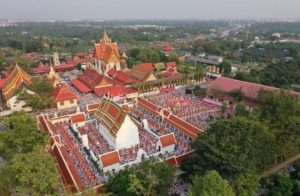
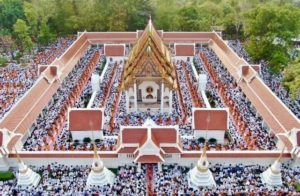
วัดโบสถ์(บน) ต.บางคูเวียง จ.นนทบุรี
อนุสรณ์สถาน ลำดับที่ ๔ สถานที่เกิดด้วยกายธรรม
第四处圣地:证悟之地——暖武里府挽果县邦库威镇博奔寺
Wat Bote-bon, Bangkuvieng, Nonthaburi
Site of the fourth Memorial Hall of Phramongkolthepmuni
Dhammakaya Attainment Site
- การเผยแผ่วิชชาธรรมกาย
7.弘扬法身法门
Propagation of the Dhammakaya Knowledge
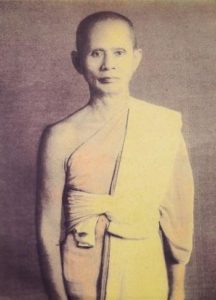
หลวงพ่อสังวาล
Ven. Luangpor Sangvarn
桑湾法师
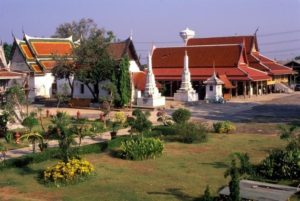
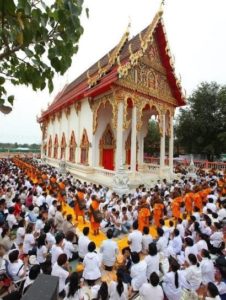
วัดบางปลา
Wat Bang-pla
邦巴寺
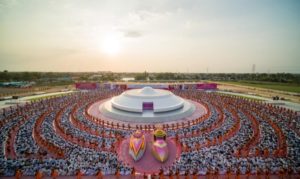
อนุสรณ์สถานบางปลา อ.บางเลน จ.นครปฐม
อนุสรณ์สถานลำดับที่ ๕ สถานที่เผยแผ่วิชชาธรรมกายครั้งแรก
The memorial hall at Wat Bang-pla, Bang-lane District, Nakorn Pathom Province
Site of the fifth Memorial Hall of Phramongkolthepmuni
First Dhammakaya Propagation Site
第五处圣地:首次弘扬法身法门之地——佛统府挽铃县邦巴寺
ปีพ.ศ.2460 หลวงปู่ได้ย้ายจากวัดโบสถ์บนไปจำพรรษาที่วัดบางปลา ซึ่งอยู่ที่ อ.บางเลน จ.นครปฐม วัดแห่งนี้เป็นวัดเก่าแก่สร้างมาตั้งแต่สมัยรัตนโกสินทร์ตอนต้น อยู่ใกล้ๆกับแม่น้ำนครชัยศรีและปากคลองบางปลานี้ เพราะหลังจากที่บรรลุธรรมเข้าถึงธรรมกายแล้วท่านเห็นในที่ว่าจะมีผู้เข้าถึงธรรมกายที่วัดบางปลา ซึ่งท่านได้สอนให้พระสงฆ์และสาธุชนฝึกสมาธิที่วัดบางปลา 4 เดือน ทำให้มีพระภิกษุ 3 รูปและคฤหัสถ์อีก 4 คน บรรลุธรรมตามอย่างท่าน
In 1917, Candasaro moved from Wat Bote-bon to Wat Bang-pla in Bang-lane District of Nakorn Pathom Province. It is an ancient temple presumed to have been constructed before the Rattanakosin period of Bangkok. The temple lies adjacent to the Nakornchaisi River and the mouth of Bang-pla Canal. After having attained Dhammakaya at Wat Bote-bon, Luangpu foresaw in his meditation that several individuals from Wat Bang-pla would attain Dhammakaya following his footsteps. After teaching meditation there for four months, three monks and four laypeople attained Dhammakaya.
佛历2460年(1917年),祖师从博奔寺前往佛统府挽铃县的邦巴寺结雨安居。这座寺院历史悠久,始建于拉达那哥欣王国早期,位于那空差西河与邦巴河的附近。祖师之所以前往该寺,是因为他在定境中看见邦巴寺将有人具足证入法身法门的机缘。后来,他在寺中指导众僧信修习禅定,四个月后,有三位比丘和四位居士证入法身。
เป็นเจ้าอาวาสวัดปากน้ำ
就任北榄寺住持
Abbot of Wat Paknam Bhasicharoen, Bangkok
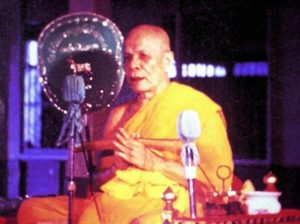
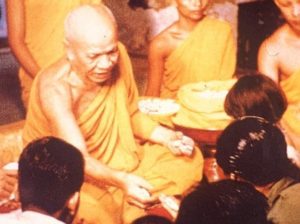
พระมงคลเทพมุนี
The Great Master Phramongkolthepmuni
帕蒙昆贴牟尼祖师
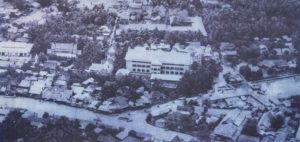
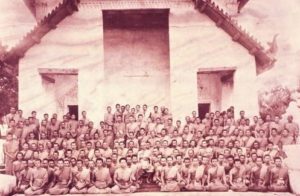
วัดปากน้ำ | ในอดีต
Wat Paknam (past)
北榄寺(从前)
วัดปากน้ำเป็นพระอารามหลวงชั้นตรี เป็นวัดเก่าโบราณสร้างมาตั้งแต่สมัยอยุธยาตอนกลาง(ระหว่างปีพ.ศ.2031-2172) สถาปนาโดยราชวงศ์สมัยนั้น เป็นไปตามหลักฐานทางประวัติศาสตร์และโบราณวัตถุที่ค้นพบในวัด วัดปากน้ำนั้นตั้งอยู่ที่ราบลุ่มบางกอกเป็นส่วนหนึ่งของดินดอนสามเหลี่ยมปากแม่น้ำเจ้าพระยา ล้อมรอบด้วยแม่น้ำเจ้าพระยาและคลองบางกอกใหญ่ ปากทางของคลองหลวง เพราะชื่อของตำบลที่ตั้งจึงเป็นที่มาของชื่อว่า วัดปากน้ำภาษีเจริญ
北榄寺属于三级皇家佛寺,根据在寺中发现的编年史和文物推断,该寺历史悠久,始建于大城王朝中期(1488年-1629年)。位于三角洲平原的曼谷地区,周围环绕着湄南河和曼谷亚伊运河,处在邦朗运河主干道的入海口,因其所在地区的名称而取名为“帕世乍能北榄寺”。
The Great Master Phramongkolthepmuni
ท่านเจ้าประคุณสมเด็จพระวันรัต (ติสสทัตตะมหาเถระ) ซึ่งดำรงตำแหน่งเจ้าคณะแขวงภาษีเจริญ (สังกัดการปกครองคณะสงฆ์) ได้อาราธนาให้หลวงปู่มาเป็นเจ้าอาวาสที่วัดปากน้ำเมื่อปี พ.ศ.2461ซึ่งท่านได้เดินทางมาจำพรรษาพร้อมกับพระภิกษุผู้ติดตาม 4 รูป
In 1918, the position of abbot at Wat Paknam was vacant. His Holiness Somdej Phra Wannarat (Tissattamahathera), who was then the monastic governor of Bhasicharoen District, offered Candasaro the position of Acting Abbot at Wat Paknam. Four monks from Wat Phra Chetuphon accompanied Candasaro to live at Wat Paknam.
佛历2461年(1918年),管理帕世乍能区僧团的僧长——颂列帕瓦那拉大长老推荐祖师就任北榄寺住持。随后,祖师与四位法师一行前往北榄寺结雨安居。
ด้วยเหตุว่าวัดสร้างมาหลายร้อยปีมีสภาพกึ่งวัดร้างอย่างเช่นศาลาที่เก่ามาก โรงครัวก็เล็กๆ กุฏิไม่กี่หลังอีกทั้งพระภิกษุเดิมที่มีอยู่ก็มักย่อหย่อนทั้งด้านปริยัติและปฏิบัติ
由于北榄寺已有数百年历史,很多地方皆因年久失修而荒废。寺里有一座老旧的禅堂,一间狭小的厨房,僧寮更是寥寥无几。与此同时,寺里的比丘们既疏于学习经文,也懒于修习禅定。
เมื่อได้รับตำแหน่งหน้าที่เป็นเจ้าอาวาสท่านได้บริหารจัดการปกครองดูแลวัดให้มีระเบียบวินัยถูกต้องตามที่พระธรรมวินัยบัญญัติไว้เพื่อให้ทุกรูปทุกคนที่อยู่ในวัดมีข้อวัตรปฏิบัติที่ดี ท่านเริ่มให้การเทศน์สอนและให้ฝึกเจริญสมาธิภาวนาแก่ทุกรูปทุกคน รวมถึงพุทธศาสนิกชนทุกคนที่มาวัดด้วย สภาพแวดล้อมและบรรยากาศภายในวัดได้รับการปรับปรุงเปลี่ยนให้ดีขึ้นมาก มีการฝึกสอนพระธรรมเทศนาและชั้นเรียนการฝึกสมาธิที่แบ่งออกเป็นหลายระดับ วัดมีชื่อเสียงเป็นที่นิยมมากขึ้นทำให้มีสาธุชนหลั่งไหลเข้ามามากมาย การบริจาคเงินก็มีมาก การจัดหาทุนเพื่อให้ร่วมพิธีกรรมต่างๆ ภายในวัดก็มีหลายอย่าง หลวงปู่ได้ปฏิสังขรณ์อาคารต่างๆ จัดการระบบการปกครองทำให้วัดได้รับการยกระดับมีชื่อเสียงเลื่องลือเป็นศูนย์กลางของทั้งด้านปริยัติธรรมและด้านการสอนสมาธิภาวนา
After Candasaro Bhikkhu made his position as Abbot known to everyone, he instituted temple rules in accordance with the Monastic Discipline for everyone to abide by and he enforced these rules strictly. He began teaching Dhamma and meditation to the residents of the temple as well as the public on a regular basis. Soon, the conditions of the temple began to improve. More monks and novices joined the temple. Many more people came to his meditation classes and Dhamma training. As the temple gained popularity and followers, donations and funding for its activities began to flow. Candasaro was able to restore the temple to a fully functional Buddhist institution and raised its status to become one of the most sought after teaching institutes for scriptural studies and meditation training in the country.
Investigation of the Dhammakaya Knowledge
หลวงปู่ได้สอนการฝึกสมาธิเพื่อให้เข้าถึงธรรมกายที่วัดปากน้ำตลอดชีวิตของท่านนับตั้งแต่ปีพ.ศ.2478-2502 ท่านได้จัดให้มีโรงงานทำวิชชาเพื่อฝึกสอนครูสอนภาวนาผู้เชี่ยวชาญที่มีธรรมะละเอียดลึกซึ้งในการปฏิบัติธรรมสายวิชชาธรรมกายหลายระดับชั้นเรียน ทีมทำวิชชาผลัดกันทำสมาธิเจริญภาวนาเป็นกะและทำสมาธิต่อเนื่องกันตลอด 24 ชั่วโมง ไม่มีเวลาหยุดพักเลย งานที่ได้รับมอบหมายนี้เป็นงานเกี่ยวกับการค้นคว้าเรื่องทางจิตตามแนววิชชาธรรมกาย ในโรงงานทำวิชชา ผู้ที่จะเป็นครูฝึกสอนวิชชาธรรมกายต้องสละทุกสิ่งทุกอย่างทางโลก เพื่อให้มีความปลอดกังวลเป็นอิสระในการอุทิศชีวิต ท่านเหล่านั้นทำงานจนแทบไม่มีเวลานอนหลับ การปฏิบัติธรรมสายวิชชาธรรมกายเกี่ยวเนื่องกับวัดปากน้ำทำให้หลวงปู่ท่านเป็นที่รู้จักในชื่อที่เรียกขานกันว่า หลวงพ่อวัดปากน้ำ ทุกวันนี้ผู้คนส่วนใหญ่เรียกท่านว่า หลวงปู่
โรงงานทำวิชชา ซึ่งตั้งอยู่หลังกุฏิพระเดชพระคุณหลวงปู่
The meditation workshop was located behind Luangpu’s residence.
ตลอดชีวิตเป็นระยะเวลา 41ปีนับตั้งแต่ปี พ.ศ.2461 ที่หลวงปู่วัดปากน้ำดำรงตำแหน่ง เจ้าอาวาสวัดปากน้ำเป็นต้นมา ท่านต้องรับความรับผิดชอบด้วยภาระหนักต่างๆ และพักผ่อนน้อย สังขารของท่านก็เริ่มทรุดโทรม ท่านรู้ล่วงหน้าว่าอีก 5 ปีข้างหน้าจะมรณภาพ จึงได้เตือนลูกศิษย์ทั้งหลายให้รู้ความจริงข้อนี้ ให้ช่วยกันดูแลรักษาและสืบทอดภารกิจการปฏิบัติธรรมสายวิชชาธรรมกายต่อไปแม้ท่านมรณภาพไปแล้วก็ตาม อย่าทอดทิ้ง
ในปี พ.ศ.2500 สุขภาพของหลวงปู่ก็แย่ลงไปอีก ท่านรู้ว่าไม่สามารถจะมีชีวิตอยู่ต่อไปได้ แต่ท่านก็ยังคงปฏิบัติศาสนกิจ ยังคงต้อนรับแขกที่มากราบท่านทุกวัน แจกพระของขวัญด้วยมือของท่านแก่ทุกคนด้วยตัวเอง งานอย่างนี้คนที่สุขภาพแข็งแรงก็ถือว่าเป็นงานยากลำบาก ทุกเย็นหลวงปู่จะนำการนั่งสมาธิเจริญภาวนาแก่พระภิกษุครั้งละหนึ่งถึงสองชั่วโมง ทุกคืนท่านจะแนะนำครูฝึกสอนสมาธิที่โรงงานทำวิชชา หากไม่มีหลวงปู่ทางวัดก็มีแนวโน้มที่จะเปลี่ยนทิศทางเผยแผ่ไปในด้านงานวิชาการ ศิษย์ที่ท่านสอนให้เป็นครูสอนการทำสมาธิต่างก็แยกย้ายออกไปทีละคนสองคนเพื่อไปทำสมาธิปลีกตัวอยู่ในป่าหรือไปอยู่ที่วัดอื่น
By 1957 Luangpu’s condition had worsened. He knew he could not live much longer, but he still attended to his duties as best as he could. He continued to see visitors every day and handed out the amulets personally. This was an arduous task even for a healthy person. Every evening he would call the monks to meditate near him for one or two hours. Every night he would give instructions to the Dhammakaya meditators at the workshop. As his health faltered, he no longer had the strength to train the newest workshop meditators or lead meditation sessions. Without Luangpu’s involvement, the emphasis of the temple tended to swing further and further into the direction of academic studies. One by one, his die-hard meditators left the temple for the forests or went to carry on their meditation elsewhere.
佛历2500年(1957年),祖师的病情持续恶化,他知道自己将不久于人世,但依然尽其所能履行职责。每天坚持接见访客,亲自赠与对方佛牌。就算对于一个健康的人来说,这也是一项艰巨的工作。每天傍晚,他会带领比丘打坐一两个小时,晚上又亲自给深修工厂的深修者授课。后来,他的病情日趋严重,已经无力亲自指导弟子打坐,寺院的重心也慢慢偏向学术方面。他原先指导的弟子也接二连三离开寺院,前往寂静的丛林或其他寺院修行。
ก่อนที่หลวงปู่จะมรณภาพ ท่านได้พยากรณ์ไว้ล่วงหน้าเกี่ยวกับวัดว่า วัดปากน้ำจะมีชื่อเสียงมาก จะมีลูกศิษย์ใหม่เข้ามาร่วมชุมนุมเป็นจำนวนมาก ท่านได้ยืนยันว่าวัดจะมีความเจริญรุ่งเรือง ท่านได้มีคำสั่งไม่ให้เผาร่างของท่าน ให้นำไปเก็บรักษาไว้ โดยบอกว่า “คนตายแล้วจะเลี้ยงคนที่มีชีวิตอยู่” เป็นการบอกเป็นนัยยะว่า ร่างของท่านจะดึงดูดให้ผู้คนหลั่งไหลเข้ามาแสวงบุญเยี่ยมชมวัดปากน้ำ และสักการบูชาร่างของท่าน และผู้มาแสวงบุญก็จะบริจาคให้แก่วัดด้วย นี้เป็นการหล่อเลี้ยงวัด เป็นการเลี้ยงคนเป็น (คนที่มีชีวิตอยู่) ผู้ที่มาแสวงบุญจะได้ฝึกการนั่งสมาธิตามเสียงเทปบันทึกเสียงของหลวงปู่ที่แนะนำการสอนสมาธิเจริญภาวนาในบริเวณห้องที่มีศพของท่านทอดร่างอยู่
Before Luangpu passed away, he made prophecies about the temple. He said that Wat Paknam would become very popular and there would be many new students coming to join the congregation. To ensure the prosperity of the temple, he ordered his body to be embalmed instead of cremated. He told them, “The ‘dead’ will feed the ‘living’.” In other words, this was meant to indicate that his corpse would attract pilgrims to visit Wat Paknam and pay homage. And the pilgrims will make donations to the temple, thus feeding the ‘living’. Instructions for meditation would be given to the pilgrims from a tape recording of Luangpu’s voice in the chamber where his body lies.
祖师在圆寂前曾预言:北榄寺将来会声名显赫,有许多新弟子加入团体。为了确保寺院的长久繁荣,他交代不要将他的遗体火化,而是做防腐处理后保存起来。他说:“已故者还可以养活在世之人。”换言之就是保存他的金身,可以吸引信众来北榄寺朝拜和布施,借此护持寺院和养活寺中的僧信。如今,在安奉祖师棺木的大殿中,一直播放祖师指导打坐的录音,让来朝拜的善信可以随录音修习打坐。
หลวงปู่ละสังขารไปเมื่อวันที่ 3 กุมภาพันธ์ พ.ศ.2502 สิริรวมอายุ 75 ปี 53 พรรษา
Luangpu passed away on 3 February 1959 at the age of seventy-five, ending his monastic life of fifty-three years.
最终,祖师于佛历2502年(1959年)2月3日安详示寂,世寿75岁,僧腊53年。

